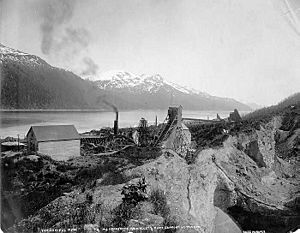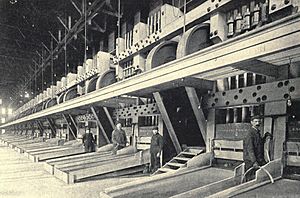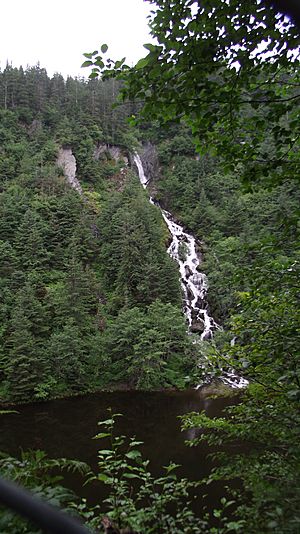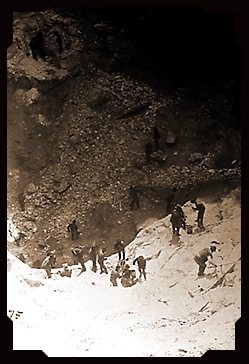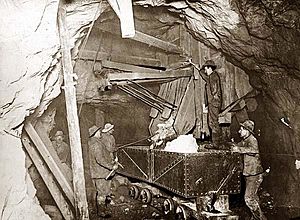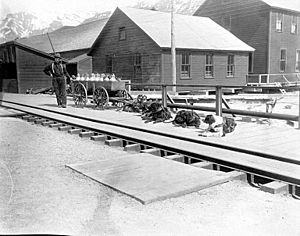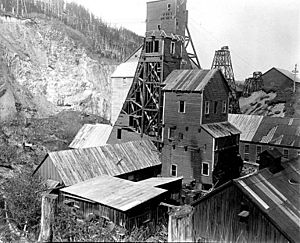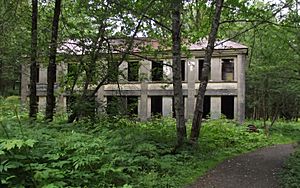Treadwell gold mine facts for kids
The Treadwell gold mine was a huge gold mine located on Douglas Island in Alaska, near the cities of Douglas and Juneau. It was started by a man named John Treadwell. This mine was once the biggest hard rock gold mine in the world. It had four main parts and employed more than 2,000 people. Between 1881 and 1922, the mine produced over 3 million troy ounces of gold. Today, only a few old buildings and a large "glory hole" (a big pit) are left. John Treadwell, who started the mine, was a carpenter by trade. He came to Alaska before the famous Klondike Gold Rush.
Contents
How the Treadwell Mine Started
In 1880, two prospectors named Joseph 'Joe' Juneau and Richard Harris found gold in an area called Silver Bow Basin. This discovery brought many people, including John Treadwell, to the region. On September 13, 1881, Treadwell bought a gold claim on Douglas Island from a man known as "French Pete."
John Treadwell first formed a business group called The San Francisco Company. However, he later decided to focus only on his property on Douglas Island. In December 1881, he bought two more claims next to his own. He then sent 22 rock samples from his claims to San Francisco, California, to be tested. The results showed that there was a good amount of gold.
On December 27, 1881, Treadwell officially started the Alaska Mill & Mining Company. Soon after, five wealthy men from California invested more than $10,000 in his company. With this new money, Treadwell began digging a tunnel. He soon realized that a lot of the gold he was finding was not on his original land. Since not many people knew about his discovery yet, he was able to buy many nearby claims for a low price. After this, he went back to San Francisco to get even more money for a much larger mill. His investors agreed, and that's how the huge mining operation began.
By 1882, a small mill with 5 stamps (machines that crush rock) was working. In 1887, a much bigger mill with 120 stamps was built. The next year, its size was doubled. Between 1883 and 1896, three more mills were added to the Treadwell complex. These mills served other mines nearby, like the Mexican, Seven Hundred Foot, and Ready Bullion mines. In 1899, a second large mill with 300 stamps was added to the main Treadwell Mine.
In 1889, John Treadwell sold his share of the company for $1.5 million and moved back to California.
Gold in the Rocks
The rocks on Douglas Island are made of different layers. Near Stephens Passage, there are green volcanic rocks. These layers then change to slate (a type of rock) closer to the Gastineau Channel. The slate layers also have many dikes (rock formations that cut through other rocks) made of diorite. The gold at Treadwell was found inside these diorite dikes. The gold was mixed with sulfide minerals, especially pyrite (also known as "fool's gold").
-
Map of the Douglas area rocks.
How the Mine Operated
At its busiest time, the Treadwell mine had five mills with over 960 stamps working all the time. They only stopped on Christmas and Independence Day. These mills crushed rocks from four main mines: the Treadwell, 700-Foot, Mexican, and Ready Bullion. At this peak, the mine employed over 2,000 people and was the largest hard rock mine in the world.
About 55% of the gold was "free milling," meaning it could be easily separated from the rock. The other 45% was mixed into pyrite and needed special processes like chlorination, smelting, and cyanidation to be taken out. The mine got its power from a plant that first used coal, then oil, and also from two hydroelectric dams.
Some of the mine shafts went very deep, as much as 2,400 feet (730 meters) below the surface.
In 1914, many miners from Serbia and Greece who worked at Treadwell left to fight in World War I for their home countries.
The Treadwell community also had its own baseball field and a team that played against other teams from Alaska and Yukon. There was even a natatorium, which had a swimming pool and basketball courts.
The Mine's End
On March 3, 1910, a huge explosion happened deep inside the Mexican mine. The blast was so powerful that 39 men and one horse were killed. This was the worst mining disaster in Alaska's history. Many of the miners who died were from other countries, with 17 deaths from Serbia alone.
The mine was still producing gold in 1917 when the Treadwell, 700-Foot, and Mexican mines suddenly started leaking water. These mines were dug more than 500 feet (150 meters) below sea level, under the Gastineau Channel. Workers quickly left the mines, and hours later, the mines collapsed. Water shot up to 200 feet (60 meters) in the air from the mine entrances. Luckily, only a dozen horses and one mule were lost.
Signs that the ground was becoming unstable had been noticed around 1909. However, there was no clear warning of a big disaster until 1913, when major shifts in the ground happened. Workers tried to add more supports, but they didn't work. The last mine shaft was used a little bit until 1922, but then the mine closed for good.
Treadwell's Population
| Historical population | |||
|---|---|---|---|
| Census | Pop. | %± | |
| 1900 | 522 | — | |
| 1910 | 1,222 | 134.1% | |
| 1920 | 325 | −73.4% | |
| 1930 | 16 | −95.1% | |
| 1940 | 13 | −18.7% | |
| U.S. Decennial Census | |||
Treadwell first appeared in the U.S. Census records in 1890, but its population was counted with Douglas. In 1900, it was listed separately as a village and was the 10th largest community in Alaska. In 1901, Treadwell officially became a town. In 1910, its population reached its highest point with 1,222 residents. At that time, it was the 6th largest city in Alaska. However, in 1912, it stopped being an official town, and its population quickly dropped as the mines closed. By 1920, only 325 people lived there. Treadwell continued to be listed as a village until 1940, but it became a "ghost town" (a deserted town) by the 1920s. By 1970, Treadwell and other places in the area became part of the city of Juneau.
Treadwell Today
Today, much of the old mine property is owned by the descendants of the Nowell family and Alaska Electric Light & Power. They have given a part of the land to the city of Juneau, with the rule that it must be kept as a historic site. A group called the Treadwell Historic Preservation & Restoration Society manages walking trails with signs that explain different parts of the old mine. Another part of the property is rented out to a company that operates a zip line.
Above where the mine collapsed, there used to be a concrete area where the Alaska Department of Transportation and Public Facilities placed a large cannon. This cannon was used to fire across the Gastineau Channel at Mount Roberts to break up avalanches before they became too big and dangerous for the road and homes nearby. However, in 2019, the cannon was removed. Now, helicopters with special devices are used to control avalanches.
|


